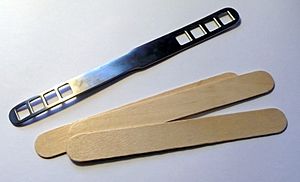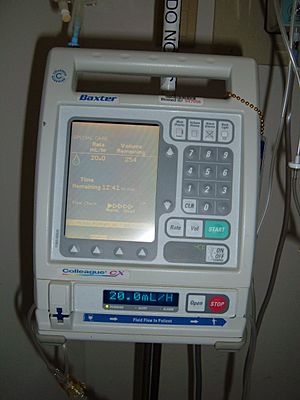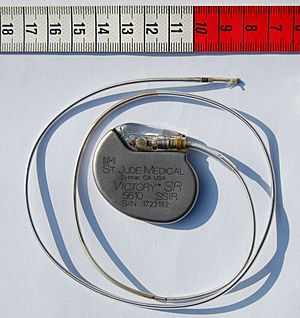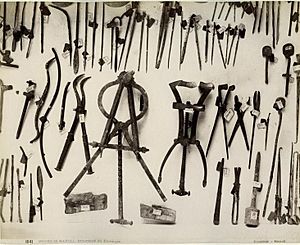Medical device facts for kids
A medical device is any tool, machine, or item used for medical reasons. This could be something simple like a tongue depressor or something very complex like a machine that helps someone breathe. Medical devices are designed to help diagnose, treat, or prevent illnesses and injuries. They can also help people recover or improve their health.
Contents
What is a Medical Device?
It can be tricky to define a medical device because different countries have their own rules. These rules help make sure that medical devices are safe and work well. One important part of the definition is making sure we know the difference between a medical device and a medicine (like a pill or liquid). This is because devices and medicines are regulated in different ways.
A Look at Medical Device History
People have been using medical devices for a very long time! About 9,000 years ago, in a place called Baluchistan, ancient dentists used tools made of flint and bowstrings to drill teeth. This shows that even in ancient times, people were inventing tools to help with health problems.
The study of old things and Roman writings also show that many kinds of medical tools were used in ancient Rome. For example, they had tools for surgery.
In modern times, governments started making rules for medical devices. In the United States, the first big law for medical devices was in 1938. Later, in 1976, more rules were added to make sure devices were safe. In Europe, similar rules came into effect in 1993. These rules are updated over time to keep up with new technologies.
Different Kinds of Medical Devices
Medical devices come in all shapes and sizes, and they do many different things!
Some are very simple and low-risk, like:
- Tongue depressors (to look at your throat)
- Medical thermometers (to check your temperature)
- Disposable gloves (to keep things clean)
- Bedpans (for patients who can't get out of bed)
Other devices are much more complex and important for life. These are often high-risk and need a lot of testing. Examples include:
- Pacemakers: Small devices with computer software that help your heart beat correctly.
- Implants: Devices placed inside the body, like artificial joints.
- Prostheses: Artificial body parts, like a fake arm or leg.
Designing these devices is a big part of a field called biomedical engineering.
Why Safety is Important
Using medical devices can sometimes have risks. Because of this, governments make sure that all medical devices are proven to be safe and effective before they can be sold. The more risk a device has, the more testing it needs to go through. Also, a device with higher risk should offer a greater benefit to the patient.
The Global Market for Medical Devices
The medical device industry is very large around the world. In 2013, it was worth about $220 to $250 billion! The United States has the biggest share of this market, followed by Europe and Japan. Within Europe, Germany, Italy, France, and the United Kingdom have the largest markets. Other countries like Australia, Canada, China, India, and Iran also have important roles in this global industry.
Images for kids
-
Bags of medical supplies and defibrillators at the York Region EMS Logistics Headquarters in Ontario, Canada
-
A stethoscope, a popular and common medical device used by doctors and nurses.
-
Spinal boards waiting to be used at the York Region EMS logistics headquarters in Ontario
See also
 In Spanish: Producto sanitario para niños
In Spanish: Producto sanitario para niños










